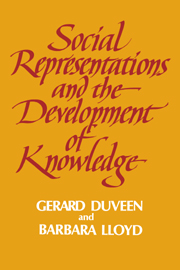Book contents
- Frontmatter
- Contents
- List of figures
- List of tables
- List of contributors
- Acknowledgements
- 1 Introduction
- 2 The underlife of the nursery school: young children's social representations of adult rules
- 3 A semiotic analysis of the development of social representations of gender
- 4 Children's representations of social relations
- 5 Social representations of childhood: an implicit theory of development
- 6 What is in an image? The structure of mothers' images of the child and their influence on conversational styles
- 7 The acquisition of reflexive social emotions: the transmission and reproduction of social control through joint action
- 8 From social cognition to social representations in the study of intelligence
- 9 Prototypes of the psychologist and professionalisation: diverging social representations of a developmental process
- 10 Social psychology and developmental psychology: extending the conversation
- Author index
- Subject index
7 - The acquisition of reflexive social emotions: the transmission and reproduction of social control through joint action
Published online by Cambridge University Press: 08 March 2010
- Frontmatter
- Contents
- List of figures
- List of tables
- List of contributors
- Acknowledgements
- 1 Introduction
- 2 The underlife of the nursery school: young children's social representations of adult rules
- 3 A semiotic analysis of the development of social representations of gender
- 4 Children's representations of social relations
- 5 Social representations of childhood: an implicit theory of development
- 6 What is in an image? The structure of mothers' images of the child and their influence on conversational styles
- 7 The acquisition of reflexive social emotions: the transmission and reproduction of social control through joint action
- 8 From social cognition to social representations in the study of intelligence
- 9 Prototypes of the psychologist and professionalisation: diverging social representations of a developmental process
- 10 Social psychology and developmental psychology: extending the conversation
- Author index
- Subject index
Summary
Introduction
In recent years there has been a considerable change in the way emotions have been conceptualised (Averill, 1974, 1976, 1980; Harré, 1986, inter alia). Underlying these more recent developments is a view of emotions as culturally and historically situated social practices. They represent essentially social psychological approaches to emotionality influenced by comparative work. Indeed there is a complementary resurgence of such work in anthropology as well (for example, Lutz, 1989). There is, however, another important issue that has remained a relatively open question, namely how such social practices are culturally transmitted from one generation to another. This invites a developmental perspective on social constructionist approaches. One interesting facet of combining these two perspectives is that it also permits a better understanding of the social origins of adult emotionality. This chapter is a preliminary contribution towards an understanding of how emotions are transmitted and the social-developmental origins of adult emotionality.
A feature of the changes that take place in early childhood is the acquisition of gradually more differentiated categorisations of self, others and the world, reflecting the appropriation of culture. Such is the case with emotions too, where one of the essential outcomes of socialisation is the acquisition of the naming rules applying to social practices in different situations. For example, in situations where embarrassment or guilt are the culturally informed and appropriate ‘names’ for the outcome of a social episode, the young child may respond in culturally uninformed and therefore ‘inappropriate’ emotional concomitants to the event.
- Type
- Chapter
- Information
- Social Representations and the Development of Knowledge , pp. 107 - 125Publisher: Cambridge University PressPrint publication year: 1990
- 10
- Cited by



